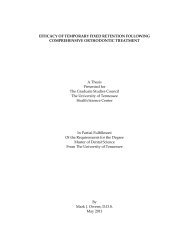BEVACIZUMAB EFFECT ON TOPOTECAN PHARMACOKINETICS ...
BEVACIZUMAB EFFECT ON TOPOTECAN PHARMACOKINETICS ...
BEVACIZUMAB EFFECT ON TOPOTECAN PHARMACOKINETICS ...
You also want an ePaper? Increase the reach of your titles
YUMPU automatically turns print PDFs into web optimized ePapers that Google loves.
The therapeutic agents depend on blood circulation to reach the targeted tissue, so<br />
the pathologic vasculature is the first determinant for drug penetration in solid tumors<br />
[38]. The distribution of the drug in tumor is governed by the blood vessel morphology<br />
and the blood flow rate in the tumor [39]. As discussed above, the number, length,<br />
diameter and geometric arrangement of blood vessels are irregular and the blood flow<br />
rate is fluctuated in solid tumors. Consequently, some regions are well perfused while<br />
other regions are totally unperfused within the same tumor [40]. Accordingly, the drug<br />
can accumulate in one region but not access another region at all. Furthermore, cessation<br />
of blood flow will reduce net tumor cell ‘exposure’ to the therapeutic agents in blood<br />
circulation and even intermittent decreases in blood flow will impact on the net<br />
distribution (AUC) of systemically administered agents [41].<br />
Additionally, the blood vessel wall in solid tumors also affects the ability of<br />
therapeutic drugs to diffuse universally to extra-vascular space [42]. The blood vessel<br />
wall is heterogeneous and hyperpermeable with thick or thin basement membrane, less or<br />
more pericytes and maximum diameter of the irregular pores [12]. The leaky wall of the<br />
blood vessel is likely to yield higher drug uptake; however, interstitial hypertension<br />
prevents the convective transport of drug between intra-vascular and extra-vascular<br />
spaces [43]. Since the interstitial pressure is high throughout the core of the solid tumor<br />
but drops dramatically in the tumor margin, the drug tends to distribute in the tumor<br />
peripheral region rather than the center of it [23], resulting less drug penetration in the<br />
core of solid tumors.<br />
Lastly, the condensed interstitium and unfavorable metabolic environment<br />
dramatically hinder the drugs from accessing tumor cells [25]. Tumor cells are highly<br />
packed, and the extracellular matrix is compressed by tumor cells, both of which reduce<br />
drug penetration in solid tumors [28]. Drug penetration and the efficacy of anticancer<br />
drugs are considerably decreased in tightly packed cells compared to loosely packed cells<br />
[44]. Similarly, the well organized and extensively interconnected collagen network in<br />
the extracellular matrix severely affects drug movement in the interstitium [25]. The<br />
harsh microenvironment with hypoxia and acidic pH may also impair drug penetration in<br />
solid tumors. For example, too much hypoxia leads the hypoxia-activated prodrugs (such<br />
as tirapazamine, AQ4N, and PR-104) to extensive metabolism, leaving no drug<br />
remaining to penetrate to the targeting sites [45]. And weak basic drugs (such as<br />
doxorubicin and mitoxantrone) or weak acidic drugs (such as methotrexate) have shown<br />
slower drug penetration in acidic solid tissues [46, 47].<br />
Thus, there are multiple determinants in solid tumors that hinder a drug from<br />
effectively penetrating to the tumor cells and exerting its cytotoxic action. In order to<br />
overcome this obstacle, many investigators have developed useful strategies to improve<br />
drug penetration in solid tumors.<br />
3
















